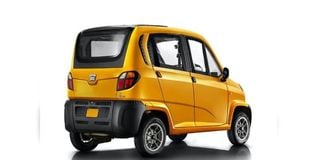Bolt plans to launch Bajaj Qute ‘car’ in Kenya market

The ride-hailing firm Bolt is planning to launch Bajaj Qute in the Kenyan market.
What you need to know:
- The Bajaj Qute is legally classified as a compact quadricycle, so technically it is not a car.
- The Bajaj Qute has a maximum speed of 70 kilometres per hour and has an eight-litre fuel tank.
Digital ride-hailing platform Bolt plans to introduce the low-cost quadricycle, Bajaj Qute on a few routes in Kenya in a strategy aimed at boosting drivers’ take-home.
Sources told the Nation that the firm could introduce the Bajaj Qute units in Kenya as early as next year —mirroring a similar move in South Africa's capital, Johannesburg.
“The thinking behind this is to make ownership easier for drivers so that their earnings are improved. Currently, most of the drivers operate units owned by third parties who demand a fee that eats up the money they make,” a source said.
“The Bajaj Qute also has a low maintenance and operation budget which makes it economically viable for both owners and operators,” added the source.
The Bajaj Qute is legally classified as a compact quadricycle, so technically it is not a car. The Bajaj Qute has a maximum speed of 70 kilometres per hour and has an eight-litre fuel tank. This means that one requires Sh1,738.88 to fill a Bajaj Qute fuel tank, going by the current Sh 217.36 a litre price of super petrol in Nairobi.
Fuel efficiency
Bolt launched the Bajaj Qute in the South African market on July 24, 2023, as a lower-cost ride option available for short trips around parts of Johannesburg.
The vehicle is capable of carrying more people, but drivers in South Africa often allow only one passenger on grounds of maintaining fuel efficiency.
In South Africa the Bajaj Qute operates under the "Bolt Lite" category which can be cheaper by 18 percent compared to the next cheapest ride option, the "Go Hatch" ride option.
The Bajaj Qute is also not convenient for passengers with lots of luggage because of its small boot space. Luggage is often placed in the back seat which limits the number of passengers.
Low-cost ride option
In Kenya, a similar strategy was deployed by taxi-hailing firm Uber through the equally low-cost Suzuki Alto model which it placed under its low-cost ride option, Uber chap chap.
Hailing apps, Bolt, and Little also took up the Suzuki Alto model which is popular due to its fuel economy, has an affordable purchase price, and has decent carrying capacity.
The Alto's full tank capacity is 35 litres which means that you require some Sh7,607.6 to fill it going by the current price of super petrol in Nairobi.
The introduction of Bajaj Qute in the Kenya market would tilt the scale against Suzuki Alto, especially among the short-distance, low-cost market segment.
Bajaj says the Qute has a high-strength, monocoque body and impact-resistant plastic closures and doors”, as well as a “reinforced rooftop.” Seatbelts are available for all occupants.





